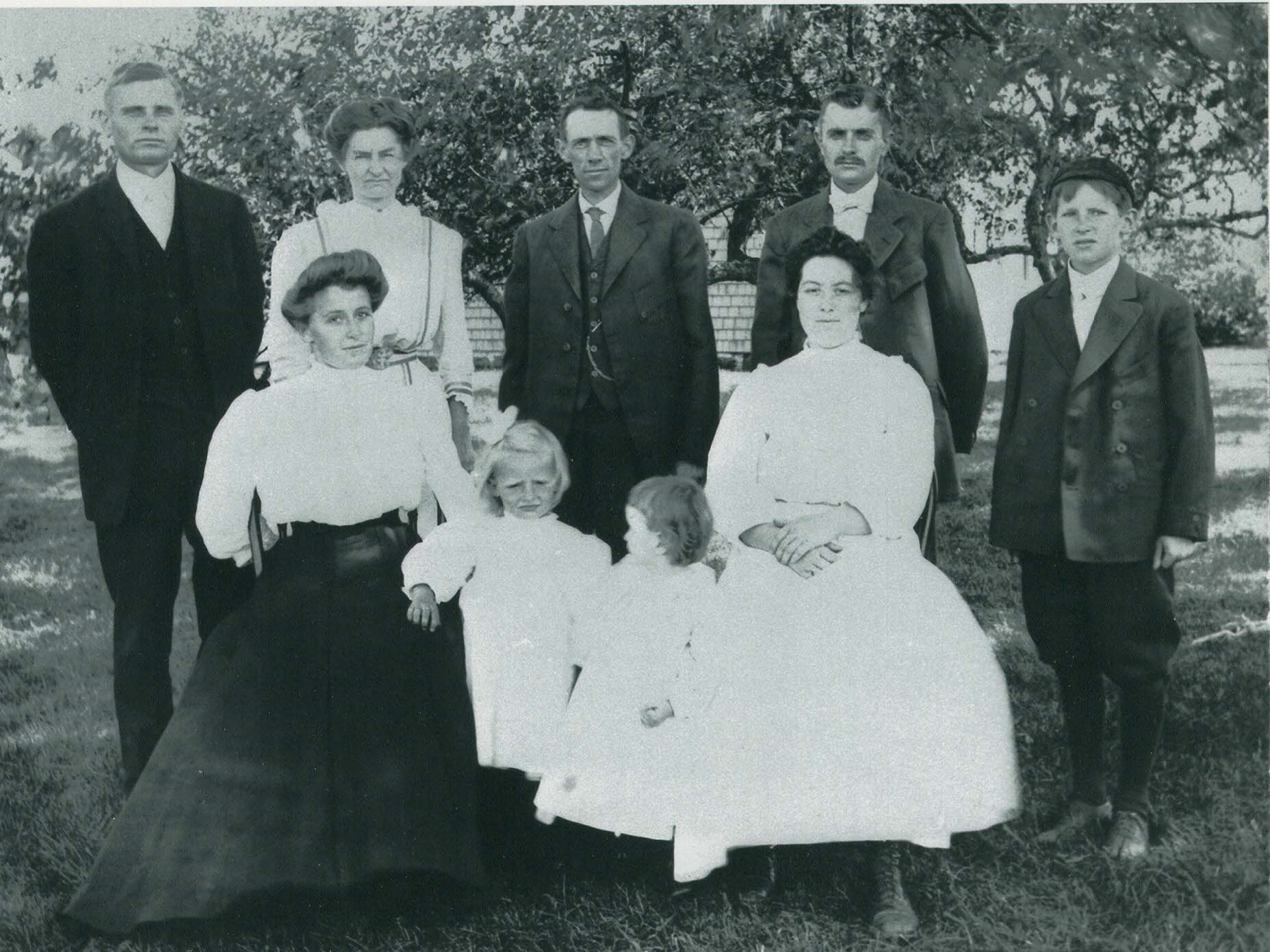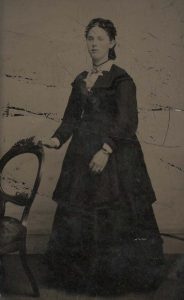
My grandfather and his cousin Emily (Morse) (Rees) Wetherbee (1906–1964), lovingly known as “Sunshine,” remained close throughout her life. Their fondness for one another is already evident in this family photo, taken in July 1909.
“Sunshine,” given the name Emily for her paternal grandmother, Emily Clapp (Waters) Morse (1855–1896), became the conduit through which remembered ties to Governor William Bradford of Plymouth Colony passed to me. The Waters family had never forgotten their link to the Mayflower. William Bradford’s grandson Elisha Bradford, in his sixties, fathered two daughters, Alice and Asenath Bradford. Alice married in 1757 Zebulon Waters of Stoughton. Their son, Asa Waters (1760–1845), who styled himself a captain after his Revolutionary War service, kept detailed genealogical records. His son, Lewis Waters (1791–1857) married his second cousin, Julia Randall (1798–1881), Asenath Bradford’s granddaughter.
 Lewis Waters Jr. (1822–1892) of Wareham assuredly had a sense of history in naming two of his children William Bradford and Alice Bradford Waters. Lewis Jr.’s daughter Emily (Waters) Morse, pictured here in a tintype taken around 1875, did not live to see any grandchildren, but her sister Julia Randall (Waters) Morse (1865–1941) found a dutiful listener in her great-niece Sunshine. In turn, Sunshine, several years before her death, made a Bradford/Waters genealogical outline for my grandfather, who kept this yellowed paper in a cubbyhole in his slant-top secretary desk. She wrote, “I was only a child when I took it down [from Aunt Julia] so may be inaccurate.” It wasn’t!
Lewis Waters Jr. (1822–1892) of Wareham assuredly had a sense of history in naming two of his children William Bradford and Alice Bradford Waters. Lewis Jr.’s daughter Emily (Waters) Morse, pictured here in a tintype taken around 1875, did not live to see any grandchildren, but her sister Julia Randall (Waters) Morse (1865–1941) found a dutiful listener in her great-niece Sunshine. In turn, Sunshine, several years before her death, made a Bradford/Waters genealogical outline for my grandfather, who kept this yellowed paper in a cubbyhole in his slant-top secretary desk. She wrote, “I was only a child when I took it down [from Aunt Julia] so may be inaccurate.” It wasn’t!
Twenty years later, when my grandfather handed me Sunshine’s sketch, I felt compelled to “do something” with this exciting information. It took me only two weeks to assemble the documentation necessary to join the General Society of Descendants through a lineage to William Bradford.[1] This rewarding experience became almost addicting in seeking more Mayflower ancestors hidden among twelve generations of my maternal families who remained in Plymouth or Barnstable Counties. While proving some Mayflower lines was accomplished by accessing books on library shelves, other quests evolved into hard-won research discoveries, especially before internet access.
For example, Levi Fish (1754–1837), buried in the Morse lot at Woodside Cemetery in Rochester, Massachusetts, did not have his marriage or children recorded in Sandwich town records. Russell Lovell, Sandwich archivist in 1985, facilitated my discovery of Levi’s marriage to Sarah Cobb, recorded in Benjamin Percival’s diary, later published as part of Sandwich Vital Records.
Mayflower passengers continue to exert their hold me, especially when they seem to be hidden in plain sight.
Working through Levi and Sarah’s ancestors, I added Mayflower passengers Thomas Rogers, Stephen Hopkins, John Howland, and Edward Fuller as supplements to my Bradford lineage. And so on. Altogether, I have documented about 30 lines to a dozen Mayflower passengers. Over the last thirty-five years, it usually provides a chuckle in the audience of Mayflower Society meetings at how many times I get to stand or raise my hand during the roll call of ancestors. Enrolling my mother and grandfather in the Vermont Society of Mayflower Descendants inspired Sunshine’s daughters and grandchildren to join the Society as well, and, thus, Sunshine’s efforts in preserving family ties has come full circle.
Avid genealogists never sit on their laurels. Mayflower passengers continue to exert their hold me, especially when they seem to be hidden in plain sight. Take this tantalizing mystery: Who was Betsy Doty of Plymouth, who married Ebenezer Besse of Wareham on 26 September 1776? That question still perplexes researchers! She does not seem to fit in the well-studied Doty/Doten families, descendants of Edward Doty. One possibility I am still exploring: Was Betsy a young widow – Elizabeth Churchill, whose marriage intention to Paul Doten Jr. was published in Plymouth on 5 November 1774? Perhaps Betsy’s identity may be solved one day with the help of DNA evidence.
As the quatercentenary of the Mayflower landing approaches, what I do contemplate? Counting Pilgrims among my forebears inspires me to reflect the full panoply of American history from 1620 [and before] to the present. I often reflect on my other immigrant ancestors who were not the right group in the right place at the right time to have their lives so richly recorded. That’s the fabric of America. The diversity of my heritage, with the acquired knowledge of those who have gone before me, has immeasurably enriched my life.
Note
[1] I served as State Historian for the Vermont Society of Mayflower Descendants from 1986 to 1996, and as Governor from 1996 to 1999.
HI Michael, I have been told by a “new” relative (someone I have met only online) that I am also a descendant of Mayflower passengers, but I haven’t been able to found out how yet. I have gone very far back on many lines, but they all arrive after the ship that landed at Plymouth. I feel inspired to figure this out as we approach this anniversary. It seems like a good time to take on this project. However, my current wish is to discover more specifically where my numerous Irish ancestors haled from. I am assuming that your Dwyers are not some of your Mayflower ancestors, and that they were more likely from Ireland. My grandmother was Ella Dwyer, and Michael is a first name found often on our Dwyer line. No surprise there! I have some great Dwyer stories in the U.S. My GG grandfather lived on Broad Street at the time of the Broad Street Riot, so I wish to research this more. Not surprisingly, it has been difficult to pinpoint where, specifically, the Dwyers were from in County Tipperary, but some indications connect us with Donaskeigh, near Dundrum, near Cashel. I wonder if you are aware of your Dwyer ancestry? I have long read your articles and have wondered this. Thanks for all of your interesting writings!
Hi Maureen,
You’re right that all the Mayflower lines come through my mother. Dad’s grandparents were from County Kerry. The family lore that our branch of the Dwyers were driven out from Tipperary in the 18th century, or earlier, seems to be validated be DNA evidence. As you know there is a significant gap in Irish Catholic before before the late 18th century. Just recently, the descendant of a “missing” sister of my great-grandmother Dwyer contacted me because of our shared DNA. Always exciting discoveries!
Michael – Mine is the opposite of yours. All Mayflower lines come through my father (actually, through his mother Fish and his grandmother Trowbridge) while my mother is the daughter of Irish immigrants. Although relatively well documented previously, I am still proving out new Mayflower lines. The Irish side is another matter. Documentation for Irish Catholics prior to around 1800 is extremely challenging but can be immensely rewarding.
I have ancestors from Northern Tipperary near Lough Derg and the Shannon River. In my research I have found Dwyers as one of the more common names.
I too heard stories that I had a Mayflower ancestor. I recently worked on documenting the Howland / Tilley connection at NEHGS. The person covering the desk said I should keep looking as names I had in my line may be connected to other passengers and she was right. I’m up to five! What a nice legacy to leave for future generations.
It is indeed a wonderful legacy. Thinking about the Bush family, I was part of a team many years ago that worked on validating President George H.W. Bush’s lineage from John Howland, the man who survived being washed overboard.
Michael – I was interested to see John Howland mentioned. When my application was accepted by the Society I was told that I was related to William Bradford and the White family. The latter I knew about because it was part of my lineage. Could you tell me where the Bradford and Howland lines come together? Most of my genealogical work is on my mother’s father’s line, Fabyan, from Isle of Shoals in mid-1600s.
Howland,
My Bradford and Morse lines came together when Emily Waters married Edwin H. Morse in 1875. My work for the General Society of Mayflower Descendants was accomplished before computer databases. I would suggest you contact your state historian or the office in Plymouth, and someone can tell you about your other Mayflower lines.
i have found that quite often when we have first and last name of a wife, but no parents, and she has a lot of progeny that could have figured it out by now, then she is a young widow.
Some long sought-after ancestors will be the cause for great rejoicing when the pieces eventually fall into place. The widow theory seems best so far.
I am interested in Ebenezer and Betsy. I would love to see this brick wall broken down.
Me too! One piece of the story has been documented in an article I wrote for “The Maine Genealogist” on their daughter Lucy Besse. Ebenezer settled in Wayne, Maine, where he married his second wife around 1790. Betsy (Doten) Besse died young, probably after 1784. That’s another reason she has been so hard to trace. Lucy returned to Plymouth where she married Prince Manter in 1796.
Your article in the “The Maine Genealogist” was extremely informative. I’m just a fan of your topics. I joined the Maine Geological Society because of Lucy Besse. This summer my cousin and I are going back to Maine to walk cemeteries. If we find her, I’ll let you know.
Thanks for your comment. Lucy is buried in South Pond Cemetery in Plymouth. Her stone was faint 25 years ago. Ebenezer is buried in Dickvale Cemetery, Oxford County, Maine. His stone looks to be a later replacement. Good luck with your cemetery walk.
“This rewarding experience became almost addicting in seeking more Mayflower ancestors hidden among twelve generations of my maternal families who remained in Plymouth or Barnstable Counties.” Me too! Except for me my Mayflower ancestors, eleven discovered to date, unfolded in my paternal line of families who remained in Plymouth or Barnstable County. I suspect we may share some ancestors or at least, over the many years, they engaged with one another in the day to day activities of life. Thank you for your stories!
Thanks for your comment. I also think we probably share a lot of ancestral lines. Around 1984, I knew an Andrew Whipple who taught at Mount St. Joseph Academy in Rutland, VT.
I am he.
Great post Michael – In my humble opinion Mayflower ancestry is often the sweetest of rewards. Keep the faith sir! I have no doubt you will discover them all…..
Thanks, Jeff. Scholarship on Mayflower passengers has grown so much after the last thirty years. It’s always a joy to read of new discoveries.
My father is my link to several Mayflower passengers. Floyd E Chandler links to Richard Warren, Edward Doty, Stephen Hopkins, Francis Cooke, Isaac Allerton, and a few more. I am a DAR member under Jonathan Chandler and a Mayflower Society member under Richard Warren. I am working on the proofs for the other passengers listed above. Teri Chandler-Rosenberg
Hi Teresa! Floyd chandler I believe is my grandmas, grandfather. Kris Chandler-weisler. And I am director decendant of edward doty. Samuel sr. is 9th generation to me!